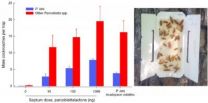(Press-News.org) EDITOR'S PICK: Potential concern about drugs in clinical trial
Drugs that enhance levels of small molecules derived naturally in the body from a major component of animal fats (small molecules known as epoxyeicosatrienoic acids [EETs]) are currently in clinical trials for the treatment of high blood pressure and diabetes. A team of researchers — led by Dipak Panigrahy and Mark Kieran, at the Dana-Farber Cancer Institute, Boston; Sui Huang, at the Institute for Systems Biology, Seattle; and Darryl Zeldin, at the National Institute of Environmental Health Science, Research Triangle Park — has now generated data in mice that raise concern about the use of these drugs in humans.
The key observation of the team was that EETs promote primary tumor growth and spread to distant sites (metastasis) in a variety of mouse models of cancer. As noted by the authors and, in an accompanying commentary, Raymond DuBois and Dingzhi Wang, at The University of Texas MD Anderson Cancer Center, Houston, the data generated suggest not only that raising levels of EETs in humans could have severe adverse effects but also that EET antagonists could provide a new approach to preventing and treating metastasis.
TITLE: Epoxyeicosanoids stimulate multiorgan metastasis and tumor dormancy escape in mice
AUTHOR CONTACT:
Dipak Panigrahy
Dana-Farber Cancer Institute, Harvard Medical School, Boston, Massachusetts, USA.
Phone: 617-919-2198; Fax: 617-730-0231; E-mail: dipak.panigrahy@childrens.harvard.edu.
Sui Huang
Institute for Systems Biology, Seattle, Washington, USA.
Phone: 206-354-3569; Fax: 206-732-1299; E-mail: sui.huang@systemsbiology.org.
Mark W. Kieran
Dana-Farber Cancer Institute, Harvard Medical School, Boston, Massachusetts, USA.
Phone: 617-632-4907; Fax: 617-632-4897; E-mail: mark_kieran@dfci.harvard.edu.
Darryl C. Zeldin
National Institute of Environmental Health Science, NIH, Research Triangle Park, North Carolina, USA.
Phone: 919-541-1169; Fax: 919-541-4214; E-mail: zeldin@niehs.nih.gov.
View this article at: http://www.jci.org/articles/view/58128?key=0c8bd9a605072d7d0278
ACCOMPANYING COMMENTARY
TITLE: Epoxyeicosatrienoic acids: a double-edged sword in cardiovascular diseases and cancer
AUTHOR CONTACT:
Raymond N. DuBois
The University of Texas MD Anderson Cancer Center, Houston, Texas, USA.
Phone: 713-745-4495; Fax: 713-792-6375; E-mail:
rdubois@mdanderson.org.
View this article at: http://www.jci.org/articles/view/61453?key=e8ce6b5c07973027cbe1
EDITOR'S PICK: Blood pressure drug limits cigarette smoke–induced lung injury in mice
Chronic obstructive pulmonary disease (COPD) is among the most common causes of death in the US. It is a smoking-related disease for which there are currently no disease-altering therapies. However, hope that one could be developed is now provided by the work of Enid Neptune and colleagues, at Johns Hopkins University, Baltimore, in a mouse model of lung disease caused by exposure to cigarette smoke.
Neptune and colleagues found that lostartan, a drug used widely in the clinic (e.g., to treat high blood pressure), reduced lung disease in mice caused by exposure to cigarette smoke. Losartan blocks the protein angiotensin receptor type 1, and its effects on cigarette smoke–induced lung injury were a result of the fact that blocking angiotensin receptor type 1 leads to a decrease in levels of the soluble molecule TGF-beta. The authors therefore suggest that other TGF-beta–targeted therapeutics might also be viable candidates for the treatment of COPD.
TITLE: Angiotensin receptor blockade attenuates cigarette smoke–induced lung injury and rescues lung architecture in mice
AUTHOR CONTACT:
Enid Neptune
Johns Hopkins University School of Medicine, Baltimore, Maryland, USA.
Phone: 410-955-4176; Fax: 410-955-0036; E-mail: eneptune@jhmi.edu.
View this article at: http://www.jci.org/articles/view/46215?key=1757af37800194593ae0
ONCOLOGY: A full TANC(1) needed to drive rhabdomyosarcoma
Rhabdomyosarcoma (RMS) accounts for 5% of all new pediatric cancers. In some patients, RMS is caused by a genetic event that gives rise to a fusion protein (PAX-FOXO1) that drives the development of the cancer. Rene Galindo and colleagues, at the University of Texas Southwestern Medical Center, Dallas, have now generated data in Drosophila and mammalian models that provide new insight into the molecular mechanisms by which PAX-FOXO1 drives the development of cancer. These data, which indicate a key role for the protein TANC1 in RMS driven by PAX-FOXO1, have identified new avenues of research for those seeking to develop candidates for targeted RMS therapy.
TITLE: Drosophila and mammalian models uncover a role for the myoblast fusion gene TANC1 in rhabdomyosarcoma
AUTHOR CONTACT:
Rene L. Galindo
University of Texas Southwestern Medical Center at Dallas, Dallas, Texas, USA.
Phone: 214-648-4116; Fax: 214-648-4070; E-mail: rene.galindo@utsouthwestern.edu.
View this article at: http://www.jci.org/articles/view/59877?key=d24a5f9b7050c9b5a16b
ONCOLOGY: Growth factor link to breast cancer
The growth factor IGF-1 has been implicated in the development of breast cancer. A team of researchers led by Robin Fuchs-Young, at The University of Texas M.D. Anderson Cancer Center, Smithville, has now demonstrated in mice that the level of expression of the protein estrogen receptor alpha (ER-alpha) on mammary gland cells influences whether IGF-1 can promote breast cancer. Fuchs-Young and colleagues therefore suggest that prepubertal and postmenopausal women are likely to be most susceptible to the potential breast cancer–promoting effects of increased levels of IGF-1, since these are the times in a woman's life when ER-alpha levels are highest.
TITLE: Developmental stage determines estrogen receptor alpha expression and nongenomic mechanisms that control IGF-1 signaling and mammary proliferation
AUTHOR CONTACT:
Robin Fuchs-Young
The University of Texas M.D. Anderson Cancer Center, Smithville, Texas, USA.
Phone: 512-237-9547; Fax: 512-237-6440; E-mail: rfyoung@mdanderson.org.
View this article at: http://www.jci.org/articles/view/42204?key=7e26e09e330e04540afb
METABOLIC DISEASE: Heparan sulfate: protecting the cells destroyed in type 1 diabetes
Type 1 diabetes is a lifelong disease characterized by high levels of sugar (glucose) in the blood. It is caused by the patient's immune system attacking and destroying the cells in their pancreas that produce the hormone insulin, which regulates blood glucose levels. Surprisingly, little is known about the mechanisms regulating the sensitivity and resistance of these cells, which are known as beta-cells, to immune system attack. Now, Charmaine Simeonovic and colleagues, at The Australian National University, Australia, have determined that the molecule heparan sulfate is essential for mouse beta-cell survival. Importantly, in a mouse model of type 1 diabetes, production of an active heparan sulfate–degrading protein (heparanase) was associated with beta-cell destruction, while treatment with an inhibitor of heparanase protected the mice from disease. Simeonovic and colleagues therefore suggest that maintaining expression of heparan sulfate on beta-cells could provide a new approach to preventing the development of type 1 diabetes.
TITLE: Heparan sulfate and heparanase play key roles in mouse beta-cell survival and autoimmune diabetes
AUTHOR CONTACT:
Charmaine J. Simeonovic
The John Curtin School of Medical Research, The Australian National University, Canberra, Australia.
Phone: 61-2-6125-4709; Fax: 61-2-6125-2595; E-mail: Charmaine.Simeonovic@anu.edu.au.
View this article at: http://www.jci.org/articles/view/46177?key=f37890b794c1c03854d8
GENETICS: Linking genetic variation to changes in protein function
Many common human diseases, including type 2 diabetes, are thought to arise as a result of both genetic and environmental factors. It is hoped that defining the genetic component of such diseases could provide not only insight into cause but also candidate therapeutic approaches. In this context, variants of the GCKR gene have been suggested to be clinically important, with some linked to type 2 diabetes. However, how these variants affect protein function and influence disease has not been determined. Now, a team of researchers led by Francis Collins, at the National Human Genome Research Institute, Bethesda, has characterized the function of a large number of variants of the GCKR gene. The data generated indicate that the majority of the GCKR variants tested do affect protein function and are likely to provide an important genetic component of several clinical conditions.
TITLE: Correlation of rare coding variants in the gene encoding human glucokinase regulatory protein with phenotypic, cellular, and kinetic outcomes
AUTHOR CONTACT:
Francis S. Collins
National Human Genome Research Institute, National Institutes of Health, Bethesda, Maryland, USA.
Phone: 301-496-2433; Fax: 301-402-2700; E-mail: collinsf@mail.nih.gov.
View this article at: http://www.jci.org/articles/view/46425?key=6490486025063609e222
ENDOCRINOLOGY: Sugar overload: refining the role of the hormone GLP-1
How does the body deal with the sudden influx of sugar that it receives after we have eaten a meal? The answers to this question not only provide insight into how the body works but can yield information that could be useful in the development of new therapeutic approaches to treating type 2 diabetes, a chronic disease characterized by high levels of sugar (glucose) in the blood. In relation to this question, Daniel Drucker and colleagues, at the University of Toronto, Toronto, have investigated in detail the function of the hormone GLP-1, which is produced by cells in the gut after food ingestion. They find that GLP-1 acts directly on cells in the pancreas to control the production of insulin, the hormone that controls blood glucose levels. These data refine our understanding of the complexity of the response to sudden sugar influx.
TITLE: Pancreatic GLP-1 receptor activation is critical for incretin control of glucose metabolism in mice
AUTHOR CONTACT:
Daniel J. Drucker
Mount Sinai Hospital, University of Toronto, Toronto, Ontario, Canada.
Phone: 416-361-2661; Fax: 416-361-2669; E-mail: d.drucker@utoronto.ca.
View this article at: http://www.jci.org/articles/view/42497?key=3ec16515fd8d7e92fe24
### END
JCI online early table of contents: Dec. 19, 2011
2011-12-19
ELSE PRESS RELEASES FROM THIS DATE:
Eating less keeps the brain young
2011-12-19
Overeating may cause brain aging while eating less turns on a molecule that helps the brain stay young.
A team of Italian researchers at the Catholic University of Sacred Heart in Rome have discovered that this molecule, called CREB1, is triggered by "caloric restriction" (low caloric diet) in the brain of mice. They found that CREB1 activates many genes linked to longevity and to the proper functioning of the brain.
This work was led by Giovambattista Pani, researcher at the Institute of General Pathology, Faculty of Medicine at the Catholic University of Sacred Heart ...
Brain function - A new way to measure the burden of aging across nations
2011-12-19
Cognitive function may be a better indicator of the impact of aging on an economy than age-distribution, with chronological age imposing less of a social and economic burden if the population is "functionally" younger, according to a study published today in the Proceedings of the National Academy of Sciences.
The study finds that one standardized indicator of cognitive ability - memory recall - is better in countries where education, nutrition, and health standards are generally higher. Aging populations are of concern to many countries as it is often assumed that ageing ...
Legumes give nitrogen-supplying bacteria special access pass
2011-12-19
A 125-year debate on how nitrogen-fixing bacteria are able to breach the cell walls of legumes has been settled. A paper to be published on Monday by John Innes Centre scientists reports that plants themselves allow bacteria in.
Once inside the right cells, these bacteria take nitrogen from the air and supply it to legumes in a form they can use, ammonia. Whether the bacteria breach the cell walls by producing enzymes that degrade it, or the plant does the work for them, has been contested since an 1887 paper in which the importance of the breach was first recognised.
"Our ...
Researchers find misinformation about emergency contraception common in low-income neighborhoods
2011-12-19
Boston – Researchers from Boston Medical Center (BMC) and Boston University School of Medicine (BUSM) have found that in low-income neighborhoods, misinformation about access to emergency contraception is a common occurrence. These findings appear as a research letter in the Dec. 19 on-line issue of the Journal of the American Medical Association.
In 2009, the U.S. Food and Drug Administration facilitated access to emergency contraception among adolescents by making it available over-the-counter to individuals age 17 years and older.
From September to December 2010, ...
Targeting EETs to treat cardiovascular disease may prove a double-edged sword
2011-12-19
Boston, Mass. – A group of small molecules called EETs – currently under scrutiny as possible treatment targets for a host of cardiovascular diseases – may also drive the growth and spread of cancer, according to researchers at the Dana-Farber/Children's Hospital Cancer Center (DF/CHCC) and other institutions. Their findings also raise the possibility that drugs that block EETs could serve as a new avenue for cancer treatment.
This study, led by Dipak Panigrahy, MD, of DF/CHCC and the Vascular Biology Program at Children's Hospital Boston, appeared online December 19 ...
Cockroach hookup signal could benefit endangered woodpecker
2011-12-19
A North Carolina State University discovery of the unique chemical composition of a cockroach signal – a "Let's hook up" sex pheromone emitted by certain female wood cockroaches to entice potential mates – could have far-ranging benefits, including improved conservation of an endangered woodpecker.
Dr. Coby Schal, Blanton J. Whitmire Professor of Entomology at NC State and the corresponding author of a paper describing the discovery, says that the study, published the week of Dec. 19 in Proceedings of the National Academy of Sciences, advances the knowledge of fundamental ...
Wayne State study finds soybean compounds enhances effects of cancer radiotherapy
2011-12-19
Detroit - A Wayne State University researcher has shown that compounds found in soybeans can make radiation treatment of lung cancer tumors more effective while helping to preserve normal tissue.
A team led by Gilda Hillman, Ph.D., professor of radiation oncology at Wayne State University's School of Medicine and the Barbara Ann Karmanos Cancer Institute, had shown previously that soy isoflavones, a natural, nontoxic component of soybeans, increase the ability of radiation to kill cancer cells in prostate tumors by blocking DNA repair mechanisms and molecular survival ...
Infrared technology for measuring the effect of fire on materials
2011-12-19
This press release is available in Spanish.
The main problem associated with measuring the effects of fire on materials lies in the temperature of the flames, which reaches over 1000 ºC and can obscure the actual temperature of the material. In addition, there is the problem of the high concentration of gasses (CO2, H2O and others), which makes it difficult to obtain clear images of the sample being subjected to fire. In order to solve this problem, the UC3M scientists who developed this method used a measurement that utilizes the infrared spectrum. "To do this, ...
First aid after tick bites
2011-12-19
This press release is available in German.For years, Mrs. S. suffered from joint pain and headaches. After an odyssey through doctors' waiting rooms, one doctor diagnosed Lyme borreliosis – an infectious disease transmitted by ticks. With its bite, the parasite introduced bacteria that then spread throughout the entire body. Mrs. S. is not alone – very often, the disease is recognized too late or not at all, or is not properly treated. Doctors are provided with no clues if the characteristic redness around the bite area is missing. Left untreated, Lyme borreliosis can cause ...
Ultra-compact dwarf galaxies are bright star clusters
2011-12-19
Astronomy & Astrophysics is publishing the results of a detailed investigation of how many 'ultra-compact dwarf galaxies' (UCDs) can be found in nearby galaxy clusters. UCDs were recognized as a populous and potentially distinct class of stellar systems about a decade ago. But they are still mysterious objects that are characterized by a compact morphology (30-300 light-years in size) and high masses (more than one million solar masses). More generally, their properties (e.g., their size, shape, or luminosity) are similar to those of both star clusters and dwarf galaxies. ...


